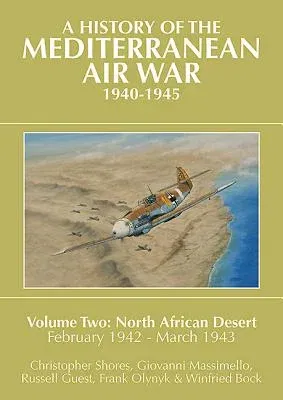The first volume of this series dealt with the initial 19 months of the
air war over the Western Desert of North Africa. This volume picks up
the story as the 8th Army, following its hard-fought success in
Operation Crusader, was forced back to the Gazala area, roughly midway
between the Cyrenaican/Tripolitanian border of Libya and the frontier
with Egypt.
It covers the lull prior to the disastrous defeat of the 8th Army in
June 1942 and the loss of the important port and fortress of Tobruk. The
costly efforts of the Allied air forces to protect the retreating
British and Commonwealth troops and prevent this turning into a rout is
examined in depth. So too is the heavy fighting which followed in the El
Alamein region as the line was stabilized. This period was ameliorated
somewhat for the Western Desert Air Force by the arrival - at last - of
the first Spitfires. The buildup of both the army and air force which
followed, coupled with new commanders on the ground, meant that Rommel's
Deutsche Afrika Korps was defeated at Alam el Halfa at the start of
September, and then again, comprehensively, at the climactic battle of
El Alamein in October.
Joined now by the first units of the United States Army Air Force, the
Allied air forces began to achieve a growing ascendancy over those of
the Axis. The long, rather slow, pursuit of the Italo-German forces
right across Libya is recounted, including the capture of Tripoli,
followed by the breakthrough into Southern Tunisia at the end of March
1943. This allowed a linkup with the Allied forces in Tunisia (whose
story will be related in Volume 3) to be achieved. In this volume follow
to the fortunes of some of the great fighter aces of the Desert campaign
such as Jochen Marseille and Otto Schulz of the Luftwaffe, Franco
Bordoni-Bisleri of the Regia Aeronautica and Neville Duke, Billy Drake
and 'Eddie' Edwards of the Commonwealth air forces.
While the fighting above the constantly moving front lines form the main
narrative of this book, the Allied and Axis night bombing offensives and
the activities of the squadrons cooperating with the naval forces in the
Mediterranean are certainly not neglected.

